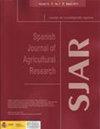Development and evaluation of a machine vision-based cotton fertilizer applicator
IF 0.8
4区 农林科学
Q3 AGRICULTURE, MULTIDISCIPLINARY
引用次数: 0
Abstract
Aim of study: To develop and assess a cotton fertilizer applicator integrated with a Machine Vision Based Embedded System (MVES) to achieve precise and site-specific fertilization. Area of study: The investigation was performed in the Indian Institute of Technology, Kharagpur. Material and methods: The MVES included a cotton detection system with a web camera, processor (computer), and python-based algorithm, and a fertilizer metering control unit with a stepper motor, motor driver, power supply, and microcontroller. The python-based algorithm in the computer predicts the presence (or absence) of cotton plants, whenever an input image is received from the camera. Upon cotton detection, it transforms into a Boolean signal sent to the microcontroller via PySerial communication, which instructs the motor to rotate the metering unit. Motor adjusts the speed of metering unit based on machine speed measured through a hall sensor, ensuring site-specific delivery of metered fertilizer A developed lab setup tested the MVES, experimentally examining performance indicators. Main results: The MVES obtained a MAPE of 5.71% & 8.5%, MAD 0.74 g/plant & 1.12 g/plant for urea and DAP (di-ammonium phosphate), respectively. ANOVA revealed no statistically significant effect of forward speed on the discharge fertilizer amount (p>0.05). For urea, discharge rates ranged from 1.03 g/s (at 10 rpm, 25% exposure length of metering unit) to 40.65 g/s (at 100 rpm, 100% exposure). DAP ranged from 1.43 to 47.66 g/s under similar conditions. Research highlights: The delivered application dosage conformed the recommended dosage. The developed MVES was reliable, had a quick response, and worked properly.开发和评估基于机器视觉的棉花施肥机
研究目的开发和评估与基于机器视觉的嵌入式系统(MVES)集成的棉花施肥机,以实现精确和因地制宜的施肥。研究领域:调查在哈拉普尔印度理工学院进行。材料和方法:MVES 包括一个带网络摄像头、处理器(计算机)和基于 python 算法的棉花检测系统,以及一个带步进电机、电机驱动器、电源和微控制器的肥料计量控制单元。计算机中基于 python- 的算法可在接收到摄像头输入图像时,预测是否存在棉花植株。一旦检测到棉花,它就会转换成布尔信号,通过 PySerial 通信发送到微控制器,指示电机旋转计量装置。电机根据霍尔传感器测得的机器速度调整计量装置的转速,确保根据具体地点提供计量肥料。主要结果:MVES 的 MAPE 分别为 5.71% 和 8.5%,尿素和磷酸二铵的 MAD 分别为 0.74 克/株和 1.12 克/株。方差分析显示,前进速度对排肥量没有显著影响(p>0.05)。尿素的排肥速率从 1.03 克/秒(10 转/分,计量装置 25% 接触长度)到 40.65 克/秒(100 转/分,100% 接触长度)不等。在类似条件下,磷酸二铵的排出率从 1.43 克/秒到 47.66 克/秒不等。研究亮点施用剂量符合推荐剂量。开发的 MVES 可靠、反应迅速、工作正常。
本文章由计算机程序翻译,如有差异,请以英文原文为准。
求助全文
约1分钟内获得全文
求助全文
来源期刊

Spanish Journal of Agricultural Research
农林科学-农业综合
CiteScore
2.00
自引率
0.00%
发文量
60
审稿时长
6 months
期刊介绍:
The Spanish Journal of Agricultural Research (SJAR) is a quarterly international journal that accepts research articles, reviews and short communications of content related to agriculture. Research articles and short communications must report original work not previously published in any language and not under consideration for publication elsewhere.
The main aim of SJAR is to publish papers that report research findings on the following topics: agricultural economics; agricultural engineering; agricultural environment and ecology; animal breeding, genetics and reproduction; animal health and welfare; animal production; plant breeding, genetics and genetic resources; plant physiology; plant production (field and horticultural crops); plant protection; soil science; and water management.
 求助内容:
求助内容: 应助结果提醒方式:
应助结果提醒方式:


